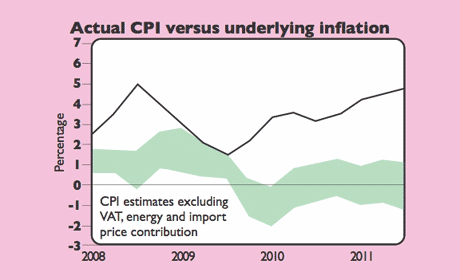
With UK inflation (as measured by the consumer price index – CPI) still well above the Bank of England’s target rate, the press is fretting about the risks of runaway inflation. At first glance, that seems sensible. Quantitative easing (QE) is effectively money printing, and is now on track to reach almost 20% of GDP. That looks very inflationary.
But in fact, rising prices are not always the same thing as inflation. That may sound odd. Yet while it is undoubtedly true that more expensive heating bills, petrol, warm clothes and supermarket shops inflate our cost of living, it is not true to say that they are inflationary. Just the opposite, in fact. When the price of imported consumer necessities goes up, it acts like a tax – only you don’t even get the boost of extra government spending to go with it.
The CPI basket isn’t even a very good measure of the cost of living. It gives a pretty good insight into the weekly household shopping basket, but it is constantly meddled with, making it more subjective than most realise.
Far bigger problems arise when we consider what CPI doesn’t include. It leaves out many of the services we pay for as well as most assets, such as real estate and pensions. Since the middle classes spend far more in their lives on items excluded from the CPI than on those in it, CPI for them is of borderline relevance.
Another problem with CPI is what to do about consumer taxes. The VAT rise is thought to account for at least one percentage point of current CPI. It drops out completely at the start of 2012. Yet we still say CPI is 5%, not 4%, which naturally causes concern.
So what is inflation, if it’s not the CPI? Inflation is anything that acts to bring forward spending from the future into the present, either because you expect the price to be higher if you wait, or because credit availability means you can buy it today rather than tomorrow. The credit bubble we experienced before the crisis stimulated growth yesterday by eroding savings (growth tomorrow).
Deflation acts to delay purchases from today until tomorrow. This might be because you expect prices to fall, or because credit has seized up, or because you have cut your spending due to fears over the economic outlook, or because your discretionary income is being squeezed by higher taxes.
Imagine you have £100 of post-tax income. You spend £20 on necessities such as food and energy, leaving £80 for luxuries. If you also buy £20 worth of luxuries on your credit card, you’ll have actually spent £100 on discretionary items. But if energy and food costs double to £40 while your bank insists you pay back £10 rather than borrow another £20, your disposable discretionary income has suddenly halved from £100 to £50. Unless you get a pay rise of £50 to compensate, you’ll have to delay buying luxuries, and that’s deflationary.
Today’s weak labour market means that wages aren’t rising to compensate. In fact, real wages have been shrinking for the last three years. The credit crunch makes things worse because households and firms are less able to borrow now to fund previous levels of spending. As a result, private-sector GDP is shrinking.
So the Bank of England has been absolutely right to ease monetary policy. The lowest base rate for 317 years and QE have both been needed to neutralise the strongest deflationary forces we have faced in our lifetimes. This also happened during the ‘inflation’ of the ‘oil shock’, when the bank kept real UK base rates deeply negative for most of the 1970s.
What about Milton Friedman’s statement that inflation is “always and everywhere a monetary phenomenon”? Well, if you look at broad money supply compared to nominal GDP, you’ll find that it is barely growing. Indeed, without the first batch of QE, Britain’s broad money supply would have shrunk by £200bn, or 13%, between March 2009 and March 2010. Money supply growth has been close to negative over the last couple of quarters, which is why QE2 was needed to ensure it remains positive. So QE is not inflationary, it is merely preventing outright deflation.
So what would the inflation rate look like if we excluded VAT and imported staples? According to the bank, all of today’s headline CPI can be accounted for by VAT, energy and higher import prices (see chart). Underlying CPI may even have been sub-zero over the last two years. Knock out QE, which has propped up CPI by between 0.75% and 2.5%, and underlying core deflation would by now be negative 1%-2%. Nihon ni yokoso! (Welcome to Japan!).
What does this mean for your money? Gilt yields will keep falling, although many believe they can go no lower. You should also stick with high-yielding blue chips that can withstand a recessionary environment. Finally, more deflation means more QE, which will weaken the pound – so buy dollar-denominated assets.
• James Ferguson is head of strategy at Arbuthnot Securities.